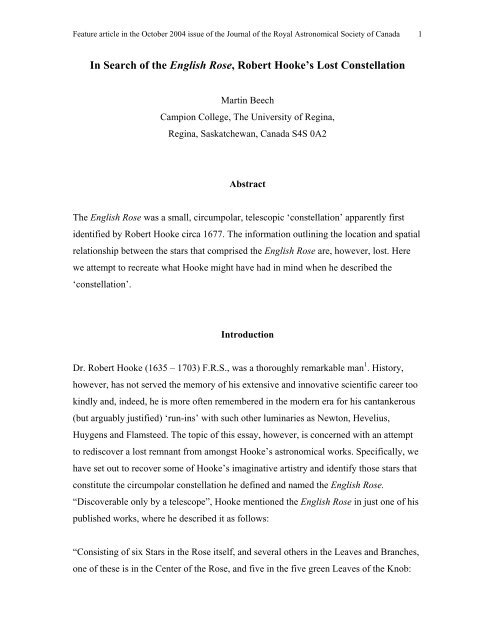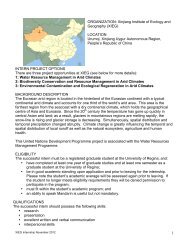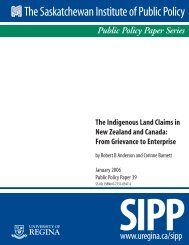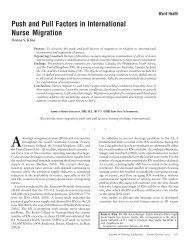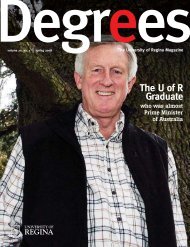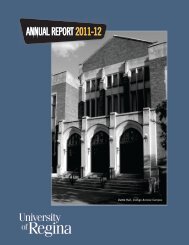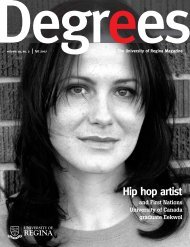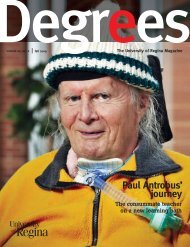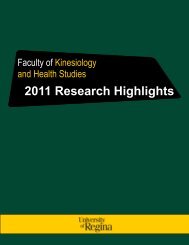In Search of the English Rose - University of Regina
In Search of the English Rose - University of Regina
In Search of the English Rose - University of Regina
Create successful ePaper yourself
Turn your PDF publications into a flip-book with our unique Google optimized e-Paper software.
Feature article in <strong>the</strong> October 2004 issue <strong>of</strong> <strong>the</strong> Journal <strong>of</strong> <strong>the</strong> Royal Astronomical Society <strong>of</strong> Canada 3<strong>the</strong> Royal Society, as well as in conjunction with his civic duties as City Surveyor <strong>of</strong>London.It would seem that <strong>the</strong>re are no specific reasons to doubt Hooke at his word concerning<strong>the</strong> discovery <strong>the</strong> <strong>English</strong> <strong>Rose</strong> sometime circa 1677. Certainly Hooke was keenlyobserving <strong>the</strong> heavens at that time and he had numerous instruments with which to makehis observations. We have not, however, been able to identify from his diary entries anyspecific time and experiment when Hooke might have discovered and/or described <strong>the</strong><strong>English</strong> <strong>Rose</strong> to Society Fellows. <strong>In</strong> addition, it seems reasonably clear from his survivingworks that Hooke made no great public advertisement <strong>of</strong> his ‘new’ constellation prior to1687, and we note that he made no mention <strong>of</strong> <strong>the</strong> <strong>English</strong> <strong>Rose</strong> in his Lecturesconcerning Navigation and Astronomy 7 read in 1683.Polar Drift, The True Meridian and LatitudeHooke included a description <strong>of</strong> <strong>the</strong> <strong>English</strong> <strong>Rose</strong> in his a Discourse <strong>of</strong> Earthquakes byway <strong>of</strong> making it an aid to <strong>the</strong> location <strong>of</strong> <strong>the</strong> north celestial pole [NCP]. The relevance <strong>of</strong>identifying <strong>the</strong> pole position being that Hooke was describing in his Discourse <strong>the</strong>procedure known to all navigators since antiquity that <strong>the</strong> altitude <strong>of</strong> <strong>the</strong> visible celestialpole corresponds to <strong>the</strong> observer’s latitude on Earth 8 . All that Hooke was encouraging atthat time [1687] was that <strong>the</strong> meridian and latitude be measured with <strong>the</strong> greatest <strong>of</strong>possible accuracy. The reason why Hooke was advocating exacting precision, however,related to his belief that “<strong>the</strong> axis <strong>of</strong> its [<strong>the</strong> Earth’s] rotation hath and doth continually bya flow <strong>of</strong> progression vary its position with respect to <strong>the</strong> parts <strong>of</strong> <strong>the</strong> Earth” 9 . WhileHooke knew that any such changes must be very small, on a time scale <strong>of</strong> say years, heargued that <strong>the</strong>y should, none <strong>the</strong> less, be measurable with ‘modern’ equipment. Just asprecession can be measured by a shift in <strong>the</strong> position <strong>of</strong> <strong>the</strong> NCP against <strong>the</strong> backgroundstars, so Hooke was suggesting that an addition motion might be present (andmeasurable) as a result <strong>of</strong> volcanically driven land mass shifting.
Feature article in <strong>the</strong> October 2004 issue <strong>of</strong> <strong>the</strong> Journal <strong>of</strong> <strong>the</strong> Royal Astronomical Society <strong>of</strong> Canada 5telescope made to take in several degrees. This he proposed as a very proper instrumentto discover <strong>the</strong> true pole-point among <strong>the</strong> telescopical fixed stars”. Unfortunately nospecifications for <strong>the</strong> telescope Hooke presented at <strong>the</strong> meeting were recorded. At <strong>the</strong>May 25 th meeting <strong>of</strong> <strong>the</strong> Society, Hooke expanded his discussion on polar drift and raiseda “suspicion <strong>of</strong> his, that <strong>the</strong> earth being made up <strong>of</strong> heterogeneous parts may have someinequality in <strong>the</strong> diurnal rotation from <strong>the</strong> different actions <strong>of</strong> <strong>the</strong> sun and moon”. Hefur<strong>the</strong>r argued that any variations in <strong>the</strong> Earth’s diurnal motion could be determined bymeasuring <strong>the</strong> crossing times <strong>of</strong> selected stars, all with <strong>the</strong> same declination, through atelescope’s field <strong>of</strong> view, at various times during <strong>the</strong> same night. Hooke followed-up on<strong>the</strong> details <strong>of</strong> this latter ‘thought experiment’ by presenting lectures at <strong>the</strong> June 8 th andJune 22 nd Society meetings on <strong>the</strong> topic <strong>of</strong> exact time measurement. While Hooke wasprepared to raise <strong>the</strong> question <strong>of</strong> a non-uniformly rotating earth in 1687, we note that one<strong>of</strong> John Flamsteed’s first research projects at <strong>the</strong> newly founded Greenwich Observatorywas, in fact, to establish that <strong>the</strong> Earth did rotate uniformly 11 . Using pendulum clocksbuilt by Thomas Tompion, Flamsteed made daily culmination measurements <strong>of</strong> <strong>the</strong> brightstar Sirius, and concluded as early as 1680 that <strong>the</strong> Earth did, indeed, rotate at an evenrate (to <strong>the</strong> accuracy measurable with <strong>the</strong> <strong>the</strong>n available instruments).The general trend in Hooke’s discussions concerning latitude determination in 1687 isone <strong>of</strong> evolving practicality. The initial method introduced on February 23 rd involved <strong>the</strong>use <strong>of</strong> a very long focal length telescope and <strong>the</strong> identification <strong>of</strong> stars in a faint, poorlyadvertised ‘constellation’. A refined, more utilitarian method using a shorter focal lengthtelescope (“1 foot, or 18 inches in length”) to locate Polaris and several o<strong>the</strong>r bright starswas introduced at <strong>the</strong> April 27 th meeting. Alternate methods based upon azimuth, altitudeand zenith angle measurements <strong>of</strong> bright stars were introduced at Society meetings heldin early April, May and June. While all <strong>of</strong> <strong>the</strong> methods for latitude and true meridiandetermination outlined by Hooke would have worked in principal, <strong>the</strong>re is no indicationthat he actually set out to perform, in any systematic manner, <strong>the</strong> measurements requiredto test <strong>the</strong> polar drift hypo<strong>the</strong>sis.Identifying <strong>the</strong> <strong>English</strong> <strong>Rose</strong>
Feature article in <strong>the</strong> October 2004 issue <strong>of</strong> <strong>the</strong> Journal <strong>of</strong> <strong>the</strong> Royal Astronomical Society <strong>of</strong> Canada 6Finding patterns between <strong>the</strong> distributions <strong>of</strong> stars on <strong>the</strong> sky is an age-old human preoccupation,and one that brings toge<strong>the</strong>r both <strong>the</strong> visual acuity and <strong>the</strong> imagination <strong>of</strong> <strong>the</strong>observer 12 . We can not be certain which stars Hooke had in mind when he identified <strong>the</strong><strong>English</strong> <strong>Rose</strong>, but <strong>the</strong>re is no specific reason to suppose that we can not ‘find’ <strong>the</strong>m againfor ourselves.From Hooke’s description in his Discourse <strong>of</strong> Earthquakes, we know that <strong>the</strong> <strong>English</strong><strong>Rose</strong> is only discernible through a telescope and that it is close to <strong>the</strong> NCP. The meetingnotes to <strong>the</strong> Society ga<strong>the</strong>ring held on February 23 rd , 1687 contain <strong>the</strong> additionalinformation:“[The] small telescopic constellation, called by him <strong>the</strong> <strong>English</strong> <strong>Rose</strong> (which he said, hehad discovered just about <strong>the</strong> present pole-point, and wherein he formerly had marked <strong>the</strong>very point) …. This method having <strong>the</strong> advantage <strong>of</strong> being [able] to be put in practice atall times <strong>of</strong> <strong>the</strong> night, when clear, and <strong>the</strong>se small stars to be seen with a two-foot glass.”We have, <strong>the</strong>refore, that <strong>the</strong> <strong>English</strong> <strong>Rose</strong> actually encompasses <strong>the</strong> NCP, or, at <strong>the</strong> veryleast, <strong>the</strong> NCP is located close to some part <strong>of</strong> its imagined figure. Fur<strong>the</strong>r, we mayassume that most, if not all, <strong>of</strong> <strong>the</strong> stars in <strong>the</strong> <strong>English</strong> <strong>Rose</strong> are fainter than an apparentmagnitude <strong>of</strong> +6, <strong>the</strong> typical clear-sky, naked-eye visibility limit. Likewise, we alsoassume that <strong>the</strong> stars in <strong>the</strong> <strong>English</strong> <strong>Rose</strong> are not so faint that a telescope with a largelight-grasp is required to reveal <strong>the</strong>m. Hooke, indeed, suggests a modest “two-foot” focallength telescope is adequate to reveal <strong>the</strong> stars. This being said, <strong>the</strong> limiting magnitude<strong>of</strong> a telescope is determined by <strong>the</strong> size <strong>of</strong> its objective and not its focal length.There are only a very few occasions in all <strong>of</strong> his written works when Hooke actuallyrefers to <strong>the</strong> diameter <strong>of</strong> <strong>the</strong> objective being employed in his telescope. One such caserelates to a 3 ½-inch diameter objective, used circa 1663, in a 36- foot focal lengthtelescope to study 13 both <strong>the</strong> Pleiades star cluster and <strong>the</strong> Orion nebula. A second instancecan be found in a letter 14 written by Hooke to Hevelius circa 1666. <strong>In</strong> this latter case, <strong>the</strong>
Feature article in <strong>the</strong> October 2004 issue <strong>of</strong> <strong>the</strong> Journal <strong>of</strong> <strong>the</strong> Royal Astronomical Society <strong>of</strong> Canada 7objective <strong>of</strong> a 60-foot telescope is described as being “a piece <strong>of</strong> glass between ¼ and ½ -inch thick, and between 5 or 6 inches over; it bears an aperture <strong>of</strong> about 3 inches,sometimes 4 or more.” Hooke’s observations on <strong>the</strong> Pleiades cluster were published inhis famous Micrographia 13 , and an inspection <strong>of</strong> <strong>the</strong> figure reproduced <strong>the</strong>rein revealsthat he was both a good observer and draftsman, and that his telescope could reveal starsdown to an apparent visual magnitude <strong>of</strong> +10.5 (and possible to magnitude +11).Certainly, <strong>the</strong> <strong>the</strong>oretical limiting magnitude achievable with a 3 ½ -inch objective is <strong>of</strong>order magnitude +14, but it is highly unlikely that any <strong>of</strong> Hooke’s objectives were closeto being ‘ideal’ 15 . It is probably safe to assume that <strong>the</strong> stars constituting <strong>the</strong> <strong>English</strong> <strong>Rose</strong>are much brighter than apparent magnitude +10. <strong>In</strong>deed, if we set a limiting magnitude <strong>of</strong>+8.5 for <strong>the</strong> stars in <strong>the</strong> <strong>English</strong> <strong>Rose</strong> <strong>the</strong>n <strong>the</strong>y should readily fall within <strong>the</strong> light-grasp<strong>of</strong> a telescope with a 1 to 1 ½ -inch (20 to 30-mm) diameter objective.Figure 1 in hereFigure 1 shows those stars brighter than a limiting magnitude <strong>of</strong> +8.5 within 5 degrees <strong>of</strong><strong>the</strong> NCP at <strong>the</strong> time Hooke was making his observations (epoch 1680) 16 . The brighteststar in <strong>the</strong> field is Polaris (α Ursae Minoris) with an apparent magnitude <strong>of</strong> +2.1. Thestars in <strong>the</strong> figure are shown with equal weight (i.e., <strong>the</strong> same sized positional dot is usedin each case) in an attempt to enhance any figurative or spatial correlation. We have used<strong>the</strong> apparent magnitude as a secondary indicator (i.e., faint stars being less ‘prominent’than bright ones to <strong>the</strong> eye) in our search. The group <strong>of</strong> stars that most clearly ‘stand-out’to <strong>the</strong> authour’s eye and which apparently ‘fit’ <strong>the</strong> description given by Hooke are joinedby solid lines, loops and ellipses in <strong>the</strong> figure 17 . <strong>In</strong> this suggested configuration, <strong>the</strong><strong>English</strong> <strong>Rose</strong> is apparently seen ‘side-on’, like a pressed flower, ra<strong>the</strong>r than from ‘above’as in <strong>the</strong> heraldic depiction <strong>of</strong> <strong>the</strong> Tudor <strong>Rose</strong>. The stars in our suggested <strong>English</strong> <strong>Rose</strong>configuration fall in <strong>the</strong> magnitude range +7.8 to +6.3, and <strong>the</strong> ‘constellation’ stretchessome 4 degrees across <strong>the</strong> sky. The NCP is located close to <strong>the</strong> ‘bend’ in what we suggestis <strong>the</strong> ‘stem’ <strong>of</strong> <strong>the</strong> <strong>Rose</strong>, and <strong>the</strong> stars that constitute <strong>the</strong> ‘leaves and petals’ are situatedalong what is now designated as <strong>the</strong> boundary between Ursa Minor and Camelopardalis.We also note that <strong>the</strong> stars SAO 1975, SAO 2012 and SAO 2010, <strong>the</strong> three brightest stars
Feature article in <strong>the</strong> October 2004 issue <strong>of</strong> <strong>the</strong> Journal <strong>of</strong> <strong>the</strong> Royal Astronomical Society <strong>of</strong> Canada 8in our evoked <strong>English</strong> <strong>Rose</strong> all have approximately <strong>the</strong> same angle <strong>of</strong> Right Ascension(RA ≈ 12 hr) and consequently <strong>the</strong>y act as convenient guide stars which ‘point’ directlytowards <strong>the</strong> NCP. As a consequence <strong>of</strong> precession <strong>the</strong> stars in our suggested <strong>English</strong> <strong>Rose</strong>are now no longer close to <strong>the</strong> NCP. <strong>In</strong>deed, <strong>the</strong> star in <strong>the</strong> <strong>English</strong> <strong>Rose</strong> that we placeclosest to <strong>the</strong> NCP, star SAO 2010, is presently separated from <strong>the</strong> pole by 2.3 degrees on<strong>the</strong> sky, as opposed to a 0.5 degree separation in 1680. Polaris has experienced <strong>the</strong> exactreverse <strong>of</strong> this displacement; it presently being 0.7 degrees from <strong>the</strong> NCP, as opposed to2.5 degrees in 1680.Just as no clearly au<strong>the</strong>nticated portrait <strong>of</strong> Hooke’s likeness has survived to <strong>the</strong> modernera 18 , so too has Hooke’s original description <strong>of</strong> <strong>the</strong> <strong>English</strong> <strong>Rose</strong> been lost. We havehere, however, sought to reconstruct <strong>the</strong> latter, and while we can not be certain that <strong>the</strong>stars as specified by Hooke have been identified, we present <strong>the</strong> construction shown infigure 1 as a possibility to what he might have had in mind.Notes and references1 See, for example, <strong>the</strong> recent books: S. <strong>In</strong>wood, The Man Who Knew Too Much(Pan Books, London, 2002); and J. Bennett, M. Cooper, M. Hunter, and L.Jardine, England’s Leonardo: <strong>the</strong> life and work <strong>of</strong> Robert Hooke (OUP, Oxford,2003). See also, A. Chapman, ‘England’s Leonardo: Robert Hooke (1635-1703)and <strong>the</strong> art <strong>of</strong> experiment in restoration England’. Proc. Royal. <strong>In</strong>st. Gt. Brit. 67.239-275 (1996).2 R. Waller (Ed.), The Posthumous Works <strong>of</strong> Robert Hooke. (Johnson ReprintCorporation, New York, 1969). pp. 279 – 450.3 R. T. Gun<strong>the</strong>r, Early Science in Oxford. vol. VII. pp. 416 – 567 (Oxford, 1930).4 H. W. Robinson and W. Adams (Eds.), The Diary <strong>of</strong> Robert Hooke: 1672 – 1680(Wykeham Publications, London. 1968).5 We leave <strong>the</strong> focal lengths in <strong>the</strong>ir original units <strong>of</strong> feet; <strong>the</strong> conversion to meters,for those that will, being made through <strong>the</strong> multiplication by 0.3048. Hooke used
Feature article in <strong>the</strong> October 2004 issue <strong>of</strong> <strong>the</strong> Journal <strong>of</strong> <strong>the</strong> Royal Astronomical Society <strong>of</strong> Canada 9long focal length objectives, as did all his contemporaries, as a means <strong>of</strong>minimizing <strong>the</strong> image-degrading effects <strong>of</strong> chromatic aberration.6 R. T. Gun<strong>the</strong>r, Early Science in Oxford. vol. VIII. pp. 31 – 114 (Oxford, 1930).7 Hooke outlines in this work a method by which an observer’s meridian can bedetermined through <strong>the</strong> measurement <strong>of</strong> <strong>the</strong> extreme eastern and <strong>the</strong> extremewestern positions <strong>of</strong> any circumpolar star. See note 2, pp. 505 – 506.8 Hooke had been ‘charged’ by <strong>the</strong> Royal Society, in June <strong>of</strong> 1669, to find a methodfor determining <strong>the</strong> “true meridian”, but in spite <strong>of</strong> additional ‘reminders’ in Apriland July <strong>of</strong> 1670, and in June <strong>of</strong> 1671, no practical method was apparentlybrought forward. The Royal Society meeting notices for April 14, 1670 do record,however, that Hooke “suggested a method for striking exact meridians by <strong>the</strong>North Star, and by observing <strong>the</strong> time <strong>of</strong> night” - see, R. T. Gun<strong>the</strong>r, EarlyScience in Oxford. vol. VI. (Oxford, 1930). <strong>In</strong> 1670, <strong>the</strong> North Star (= Polaris = αUrsae Minoris) was some 2.5 degrees angular distance from <strong>the</strong> NCP, and <strong>the</strong>method that Hooke appears to be advocating would require <strong>the</strong> determination <strong>of</strong>its times <strong>of</strong> upper and/or lower culmination. It seems clear, <strong>the</strong>n, that Hooke hadnot identified <strong>the</strong> stars in <strong>the</strong> <strong>English</strong> <strong>Rose</strong> by June <strong>of</strong> 1671, which is consistentwith his comments referenced in note 2.9 See note 2, pp. 353 – 362.10 Editorial comment by Waller. See note 2, p. 360.11 A. Chapman, Dividing <strong>the</strong> Circle: The Development <strong>of</strong> Critical AngularMeasurement in Astronomy 1500 – 1850 (Praxis Publishing Ltd., Chichester,1990). p. 50.12 There is typically only a slight or, at best, a passing similarity between <strong>the</strong> actualdistribution <strong>of</strong> stars on <strong>the</strong> sky and <strong>the</strong> constellation figure that <strong>the</strong>y are supposedto represent. Our assumption in this article, however, is that <strong>the</strong> stars thatconstituted Hooke’s <strong>English</strong> <strong>Rose</strong> did have a distribution on <strong>the</strong> sky that would begenerally ‘recognizable’ as a rose, or at least a flower-like motif.
Feature article in <strong>the</strong> October 2004 issue <strong>of</strong> <strong>the</strong> Journal <strong>of</strong> <strong>the</strong> Royal Astronomical Society <strong>of</strong> Canada 1013 R. T. Gun<strong>the</strong>r, Early Science in Oxford. vol. XIII. pp. 241 – 246 (Oxford, 1938).Hooke began his observations <strong>of</strong> <strong>the</strong> Pleiades cluster in April <strong>of</strong> 1663 - see, R. T.Gun<strong>the</strong>r, Early Science in Oxford. vol. VI. p. 128 (Oxford, 1930).14 See note 8, pp. 279 – 281. The extract quoted is from an undated letter [butdesignated circa 1666] by Hooke to Hevelius. Hooke continues in his letter, “It[<strong>the</strong> 60-ft glass] discovers many things not visible through a very good 36 [foot]glass; such as <strong>the</strong> shadows <strong>of</strong> <strong>the</strong> satellites, and <strong>the</strong> veracity <strong>of</strong> Jupiter and Marson <strong>the</strong>ir axes”. Hooke fur<strong>the</strong>r designed and presumably experimented withvariable aperture attachments. An iris-like diaphragm, for example, was describedat <strong>the</strong> July 27, 1681 meeting <strong>of</strong> <strong>the</strong> Royal Society: “Mr. Hooke showed his newcontrivedaperture for long telescopes, which would open and close just like <strong>the</strong>pupil <strong>of</strong> a man’s eye, leaving a round hole in <strong>the</strong> middle <strong>of</strong> <strong>the</strong> glass <strong>of</strong> any sizedesired; which was well approved <strong>of</strong>”. See note 3, p. 577.15 The <strong>the</strong>oretical limiting visual magnitude <strong>of</strong> a telescope with an objective <strong>of</strong>diameter D(mm) is: m = 2.7 + 5 log D. See e.g., R. Gupta (Ed.), Observer’sHandbook <strong>of</strong> The Royal Astronomical Society <strong>of</strong> Canada (<strong>University</strong> <strong>of</strong> TorontoPress, Toronto, 2004). R. Willach [The Development <strong>of</strong> Telescope Optics in <strong>the</strong>Middle Seventeenth Century, Annals <strong>of</strong> Science, 58. 381- 398 (2001)] notes,however, that circa 1610 Galileo could detect stars down to magnitude +8.5 withan objective glass <strong>of</strong> 20mm diameter. Galileo was thus ‘loosing’ about onemagnitude from <strong>the</strong> <strong>the</strong>oretical limiting magnitude <strong>of</strong> his telescope. This ‘loss’was caused by <strong>the</strong> poor optical quality <strong>of</strong> <strong>the</strong> glass available to Galileo in hisexperiments. Since <strong>the</strong> quality <strong>of</strong> optical glass hardly improved during <strong>the</strong> entirerun <strong>of</strong> <strong>the</strong> 17 th century [see e.g., M. E. Rudd, R. Willach. K. Stauberman and D.H. Jaecks, A curious Example <strong>of</strong> a Fraunh<strong>of</strong>er-Dolland Connection, Bulletin <strong>of</strong><strong>the</strong> Scientific <strong>In</strong>strument Society, No. 79. 2 – 5 (2003)] a one to two magnitudeloss from <strong>the</strong> <strong>the</strong>oretical limiting magnitude <strong>of</strong> any telescope being used byHooke would not be surprising.16 The figure has been constructed with <strong>the</strong> aid <strong>of</strong> <strong>the</strong> ‘Redshift 2’ planetariumprogram (Maris Multimedia, 1995). The program incorporates both proper motion
Feature article in <strong>the</strong> October 2004 issue <strong>of</strong> <strong>the</strong> Journal <strong>of</strong> <strong>the</strong> Royal Astronomical Society <strong>of</strong> Canada 11and precession adjustments to star locations in accordance to <strong>the</strong> prescribedviewing epoch.17 The star designations in <strong>the</strong> Smithsonian Astrophysical Observatory StarCatalogue (SAO listings) are: SAO 2012 for <strong>the</strong> ‘central knob’, with <strong>the</strong> fiveleaves being SAO 2122, SAO 2057, SAO 1975, SAO 1902, and SAO 1834. The‘stem’ is composed <strong>of</strong> <strong>the</strong> tree stars SAO 2012, SAO 2010, and SAO 1401.18 A. Chapman, ‘The astronomical works <strong>of</strong> Robert Hooke’. The Observatory. 123.241 - 245 (2003). A portrait propounded to be <strong>of</strong> Hooke has recently been found,however, and this may be viewed at <strong>the</strong> MacTutor History <strong>of</strong> Ma<strong>the</strong>maticsArchive, maintained by <strong>the</strong> <strong>University</strong> <strong>of</strong> St. Andrews. The internet URL is:www-history.mcs.st-andrews.ac.uk/history/PictDisplay/Hooke.htmlFigure caption:Figure 1. The spatial distribution <strong>of</strong> stars brighter than apparent magnitude +8.5 locatedwithin 3.5 degrees <strong>of</strong> <strong>the</strong> north celestial pole (epoch 1680). The north celestial pole(NCP) is at <strong>the</strong> center and <strong>the</strong> circle (dotted) has an angular radius <strong>of</strong> 2 degrees on <strong>the</strong>sky. The star positions are shown with ‘dots’ <strong>of</strong> equal weight (in order to enhance anyspatial correlation) and <strong>the</strong>ir apparent visual magnitudes are given in <strong>the</strong> brackets. Thedashed line in <strong>the</strong> upper right hand corner indicates <strong>the</strong> ‘tail stars’ <strong>of</strong> Ursa Minor. Oursuggested grouping for <strong>the</strong> stars in <strong>the</strong> <strong>English</strong> <strong>Rose</strong> is shown by <strong>the</strong> solid lines (<strong>the</strong>stem), ellipses (<strong>the</strong> five leaves) and arcs (<strong>the</strong> rose petals).
Feature article in <strong>the</strong> October 2004 issue <strong>of</strong> <strong>the</strong> Journal <strong>of</strong> <strong>the</strong> Royal Astronomical Society <strong>of</strong> Canada 12(7.2)δ Umi(4.4)(7.5)(8.3)(8.3)(7.0)(8.0)λ Umi(6.4)(6.5)(8.4)(7.5)RA = 14hr(6.3)NCPRA = 2hrPolaris(2.1)(7.6) (7.8)(6.3)(7.0)δ = 88 o(7.1)(8.4)(7.4)(6.4)(7.4)(5.1)(7.2)(6.6)


